
One of our resident cottontail rabbits showing how they can hide when they sit still in an open area just because they are so close to being the color of the sand and dirt.
There's somebody out there for everybody. You just have to wait for god to bring them into your life.

 Today was the first time I felt well enough to ride a roadbike since havinggotten sicklast month. It was only 26 miles, but it felt great to have my full lung capacity and energy back.
Today was the first time I felt well enough to ride a roadbike since havinggotten sicklast month. It was only 26 miles, but it felt great to have my full lung capacity and energy back. Continuing with the Italian theme, I took Francesco - my fixed gear stallion. How happy he was, basking in the precious minutes of sunshine in between thunderstorms.
Continuing with the Italian theme, I took Francesco - my fixed gear stallion. How happy he was, basking in the precious minutes of sunshine in between thunderstorms.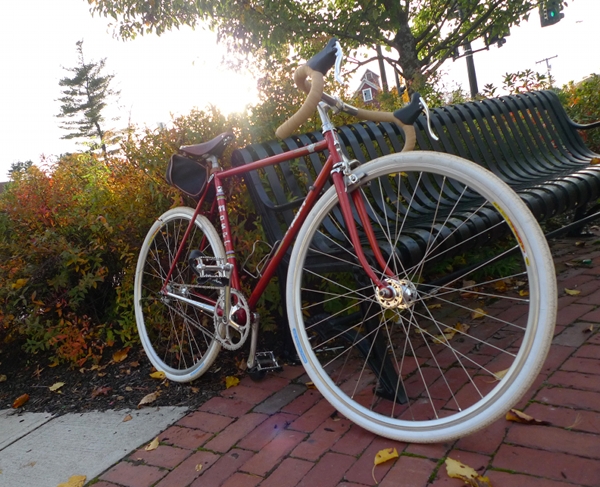 Riding a fixed gear roadbike is an experience that fills me with a special kind of enjoyment - I think because it combines the sensations of walking and flying (fly-walking?).
Riding a fixed gear roadbike is an experience that fills me with a special kind of enjoyment - I think because it combines the sensations of walking and flying (fly-walking?).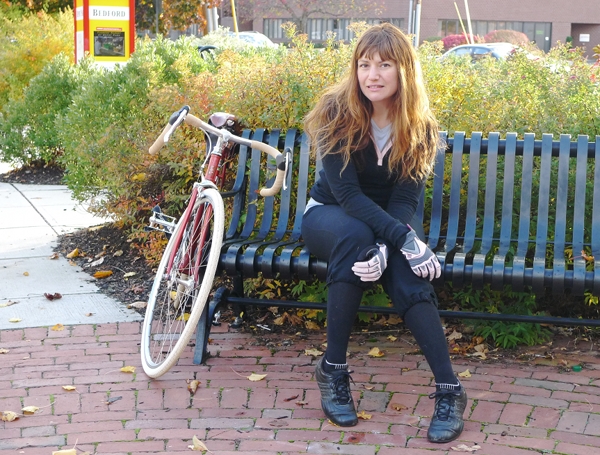 I was worried that I might be too out of shape to make it, but I had forgotten how comfortable Francesco is. The 26 miles of pedaling felt like a stroll in the park. Although, I have learned by now that even if I feel "fine" riding fixed gear while I am actually doing it, it does take more out of me than a free-wheel bicycle. I usually sleep longer after such a ride, and sometimes I am sore the following day.
I was worried that I might be too out of shape to make it, but I had forgotten how comfortable Francesco is. The 26 miles of pedaling felt like a stroll in the park. Although, I have learned by now that even if I feel "fine" riding fixed gear while I am actually doing it, it does take more out of me than a free-wheel bicycle. I usually sleep longer after such a ride, and sometimes I am sore the following day.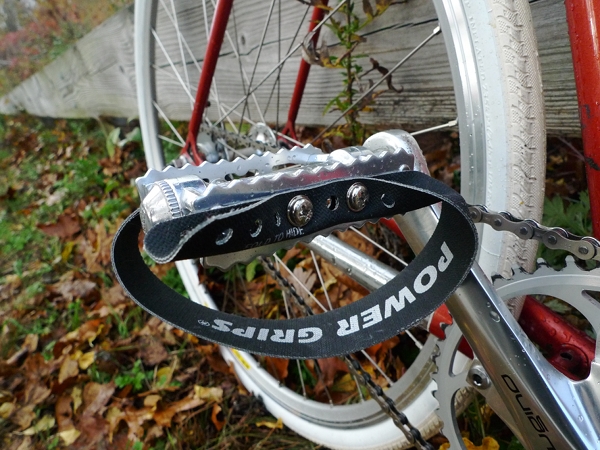 One thing that has improved my comfort level with fixed gear cycling considerably, are these "fixie" Power Grips. I wrote about the standard Power Grips here, and since my initial review I have become addicted to these things. The fixed gear version differs from the standard model, in that it makes it easier to insert and remove your feet while pedals are in motion. I cannot tell what it is about the design that makes this possible, but none the less it seems to work. I insert my right toe at the starting position and start cycling slowly while nudging the left pedal with my left toe - then swiftly insert the toe into the left grip on the first stroke. After some practice this became a familiar and instinctive sequence of movements - though it definitely helped that I was already comfortable using this system on a free-wheel bike prior to trying it on a fixed gear.
One thing that has improved my comfort level with fixed gear cycling considerably, are these "fixie" Power Grips. I wrote about the standard Power Grips here, and since my initial review I have become addicted to these things. The fixed gear version differs from the standard model, in that it makes it easier to insert and remove your feet while pedals are in motion. I cannot tell what it is about the design that makes this possible, but none the less it seems to work. I insert my right toe at the starting position and start cycling slowly while nudging the left pedal with my left toe - then swiftly insert the toe into the left grip on the first stroke. After some practice this became a familiar and instinctive sequence of movements - though it definitely helped that I was already comfortable using this system on a free-wheel bike prior to trying it on a fixed gear. Now that I am able to use foot retention on this bicycle, I am no longer apprehensive about cycling over bumps and potholes or going downhill at high speeds. The experience is pretty much perfect and very enjoyable. One thing in particular I have noticed, is how easy it is for me to ride "in the drops" - Francesco almost seems more stable when the handlebars are held this way than higher up. Is that possible?
Now that I am able to use foot retention on this bicycle, I am no longer apprehensive about cycling over bumps and potholes or going downhill at high speeds. The experience is pretty much perfect and very enjoyable. One thing in particular I have noticed, is how easy it is for me to ride "in the drops" - Francesco almost seems more stable when the handlebars are held this way than higher up. Is that possible? And another interesting thing: I find it much, much easier to get out of the saddle and pedal standing up on Francesco than I do on my other bicycles. Is it the fixed-gearness that is facilitating this or the geometry? As I've mentioned before, I have a terrible sense of balance, and that is what I believe normally prevents me from pedaling while standing up. But on this bicycle, it seems not to matter.
And another interesting thing: I find it much, much easier to get out of the saddle and pedal standing up on Francesco than I do on my other bicycles. Is it the fixed-gearness that is facilitating this or the geometry? As I've mentioned before, I have a terrible sense of balance, and that is what I believe normally prevents me from pedaling while standing up. But on this bicycle, it seems not to matter.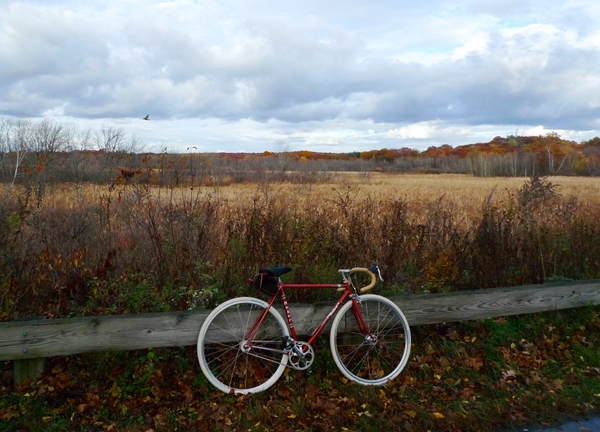 It rained on and off for the duration of our ride, and the colourful leaves strewn over the trail turned into a mess of a slippery carpet. Was I so excited to be riding Francesco that I began to imagine things, or is it easier to ride in slippery conditions on a fixed gear bike? I have read comments about traction before, but I admit that I don't understand them. Could somebody explain it in layman's terms?
It rained on and off for the duration of our ride, and the colourful leaves strewn over the trail turned into a mess of a slippery carpet. Was I so excited to be riding Francesco that I began to imagine things, or is it easier to ride in slippery conditions on a fixed gear bike? I have read comments about traction before, but I admit that I don't understand them. Could somebody explain it in layman's terms?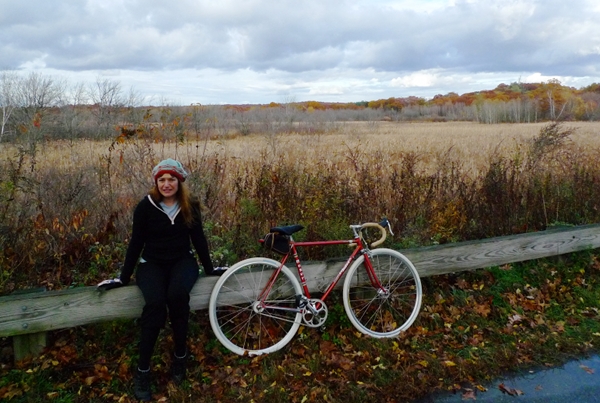 As I prepare for some more pruning of my bicycle overgrowth, it is clear to me that I "need" a fixed gear roadbike. So while I am now considering selling my Trek- which has been fun, but not essential - I will definitely be keeping the Francesco Moser.
As I prepare for some more pruning of my bicycle overgrowth, it is clear to me that I "need" a fixed gear roadbike. So while I am now considering selling my Trek- which has been fun, but not essential - I will definitely be keeping the Francesco Moser.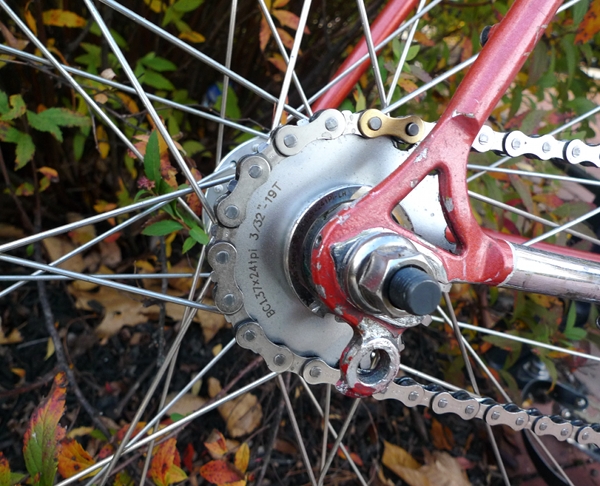 In the long run, however - maybe a couple of years from now - I will probably want to replace it with a "real" fixed gear bicycle. Mainly, this is because the Moser's bottom bracket is not as high as it should be - and even though my lean on turns is not aggressive enough to warrant worrying about pedal strike yet, it would be better if this wasn't even a potential issue.
In the long run, however - maybe a couple of years from now - I will probably want to replace it with a "real" fixed gear bicycle. Mainly, this is because the Moser's bottom bracket is not as high as it should be - and even though my lean on turns is not aggressive enough to warrant worrying about pedal strike yet, it would be better if this wasn't even a potential issue.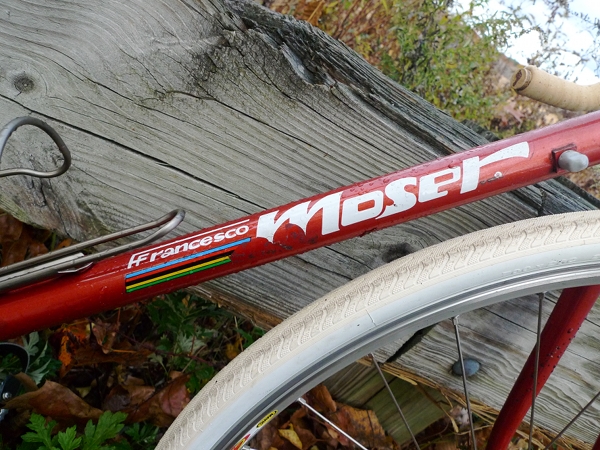 But for now,Francesco is my dashing Italian gentleman and I thank him for my happy feet.
But for now,Francesco is my dashing Italian gentleman and I thank him for my happy feet.




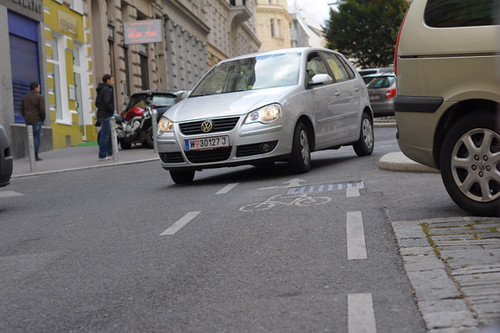 As many other cities with cycling infrastructure, Vienna is full of one way streets with bike lanes going against traffic. This is done to make travel more convenient for cyclist. The drawback is that it places cyclists and motor vehicles in situations where they can potentially collide with each other. One way this could happen is when the road is so narrow that a car cannot keep out of the bike lane entirely. Another potentially hazardous scenario is when vehicles emerge from around the corner, as shown here.
As many other cities with cycling infrastructure, Vienna is full of one way streets with bike lanes going against traffic. This is done to make travel more convenient for cyclist. The drawback is that it places cyclists and motor vehicles in situations where they can potentially collide with each other. One way this could happen is when the road is so narrow that a car cannot keep out of the bike lane entirely. Another potentially hazardous scenario is when vehicles emerge from around the corner, as shown here. When I first saw the wrong way bike lanes, I was scared to ride on them. Surely it was only a matter of time before some car or motorcycle hit me head on? However, cyclists in Vienna use these lanes all the time, and as far as I know collisions are very rare. Eventually I got used to the design and began to trust it.
When I first saw the wrong way bike lanes, I was scared to ride on them. Surely it was only a matter of time before some car or motorcycle hit me head on? However, cyclists in Vienna use these lanes all the time, and as far as I know collisions are very rare. Eventually I got used to the design and began to trust it.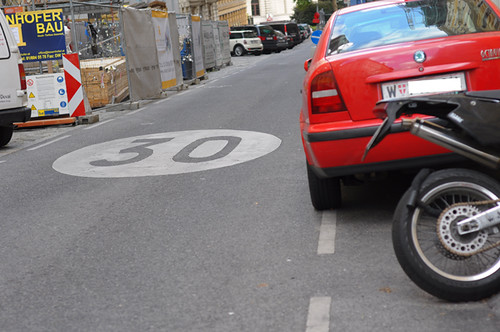 Drivers appear to be vigilant and in control of their vehicles; they can stop on a dime, and have for me. And no doubt the 30km/h (18.6mph) speed limit helps. The funny thing is that whenever I leave Vienna and remember the wrong-way bike lanes, their safety seems implausible. Only when I am here do I again believe that it's okay. What are your thoughts about this design?
Drivers appear to be vigilant and in control of their vehicles; they can stop on a dime, and have for me. And no doubt the 30km/h (18.6mph) speed limit helps. The funny thing is that whenever I leave Vienna and remember the wrong-way bike lanes, their safety seems implausible. Only when I am here do I again believe that it's okay. What are your thoughts about this design?
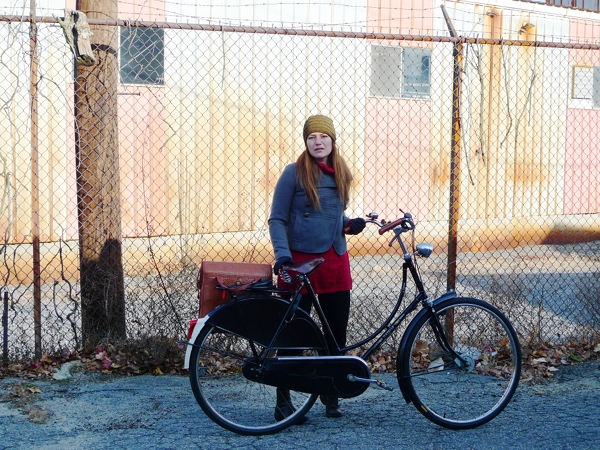 Now that it's winter, I find that strangers talk to me more than usual about cycling - typically when they see me locking up my bike. Over the past couple of weeks, several women have told me that they'd love to ride a bike, but find the logistics daunting: having to buy lights and figure out how to mount them; constantly getting flats (something they remember from previous cycling experiences); having to figure out how to carry their handbag, struggling to mount the bike in business attire, and other similar concerns. Their misgivings are fueled by the perception that cycling will complicate their lives - compared to walking, or taking public transportation, or driving.
Now that it's winter, I find that strangers talk to me more than usual about cycling - typically when they see me locking up my bike. Over the past couple of weeks, several women have told me that they'd love to ride a bike, but find the logistics daunting: having to buy lights and figure out how to mount them; constantly getting flats (something they remember from previous cycling experiences); having to figure out how to carry their handbag, struggling to mount the bike in business attire, and other similar concerns. Their misgivings are fueled by the perception that cycling will complicate their lives - compared to walking, or taking public transportation, or driving.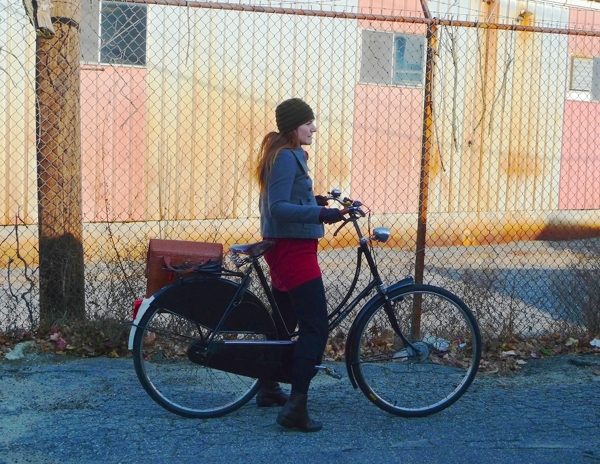 What frustrates me about this, is that all of their concerns can be addressed with the right bike. As I explain about step-through frames, dynamo lighting, tires with puncture-protection, dress guards, chain cases, and panniers that attach to the bicycle's rack in seconds, I can see the ladies' faces light up as they eye these features hungrily.
What frustrates me about this, is that all of their concerns can be addressed with the right bike. As I explain about step-through frames, dynamo lighting, tires with puncture-protection, dress guards, chain cases, and panniers that attach to the bicycle's rack in seconds, I can see the ladies' faces light up as they eye these features hungrily.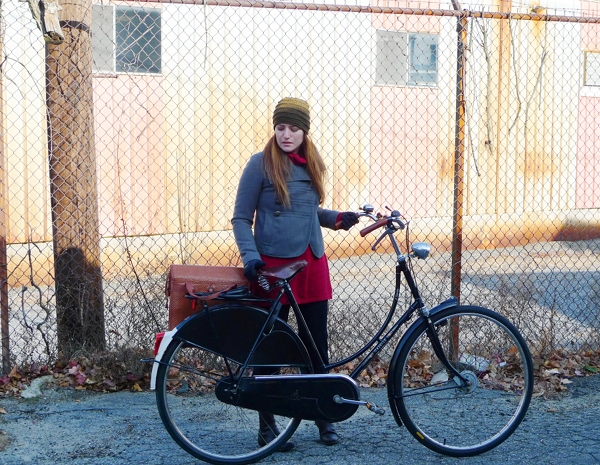 Even though I enjoy learning about bicycle design and own multiple bikes on which I constantly experiment, I am first and foremost a "transportation cyclist." My main priority is to have that one bike that is reliable, comfortable, and as low-maintenance as possible. The bicycle I use for transportation needs to make life easy for me. It needs to minimise the extent to which I think about it and tinker with it - so that I can focus on work and life itself, not on the bicycle. Skirt suit? Heavy bag? Dark outside? Raining like crazy? The "user friendly interface" on my machine accommodates all of these scenarios.
Even though I enjoy learning about bicycle design and own multiple bikes on which I constantly experiment, I am first and foremost a "transportation cyclist." My main priority is to have that one bike that is reliable, comfortable, and as low-maintenance as possible. The bicycle I use for transportation needs to make life easy for me. It needs to minimise the extent to which I think about it and tinker with it - so that I can focus on work and life itself, not on the bicycle. Skirt suit? Heavy bag? Dark outside? Raining like crazy? The "user friendly interface" on my machine accommodates all of these scenarios.
 Another picture of my grandmother (on the right) and her sister Jane. This time they are sharing a piece of watermelon. I don't recognize the background scenery so don't know where it was taken, but it was probably the summer of 1954.
Another picture of my grandmother (on the right) and her sister Jane. This time they are sharing a piece of watermelon. I don't recognize the background scenery so don't know where it was taken, but it was probably the summer of 1954.

Young Woman 1: This dress is cute, but I totally can't wear it on my bike (lifts hem and stretches it to show how narrow it is).
Young Woman 2: Yeah it sucks when a skirt is too tight and I can't bike in it. I'm like always looking for A-lines and pleats now.
YM1: Yeah I know! Or pants.
YM2: Nah I'm not really into pants. Oh but the stretchy miniskirts are good too.
YM1: Oh yeah! I just saw some over there (points at some shelves and they walk off in that direction).












Learning moves on a project. Photo: Steven Gordon
We can all readily appreciate the beauty of rock and the shapes it gives to the world, we just have to travel through the landscape. If we want to dig deeper, we can travel over mountains and look at them. A visual interaction with the rock.
Rock climbing is a deeper interaction with the rock. The medium of movement on rock allows us to crack open the beauty of rock not fully visible to the eye and get more back.
The harder the rock climb, the more we have to understand the rock to move, the more we learn. The more dangerous the rock climb, the more we have to understand the rock so we can stay alive.
The hardest and most dangerous climbs are the most meaningful, but they come at a cost most rock climbers wouldn’t dare to pay. Every climber finds their own balance of cost and reward.

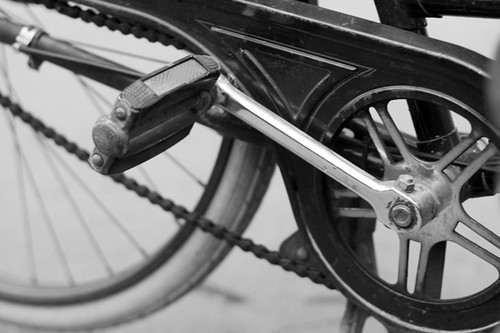 When I wrote about the modern Sturmey Archer Duomatic hub last week, a reader pointed out that vintage coaster brake hubs have"more 'backlash' - so you have to rotate the pedals further before engaging the brake." I had noticed this as well after switching back and forth between bikes with modern coaster brake hubs (SAand Shimano) and vintage ones (SAand Sachs).
When I wrote about the modern Sturmey Archer Duomatic hub last week, a reader pointed out that vintage coaster brake hubs have"more 'backlash' - so you have to rotate the pedals further before engaging the brake." I had noticed this as well after switching back and forth between bikes with modern coaster brake hubs (SAand Shimano) and vintage ones (SAand Sachs)..jpg) One of the neat things about this site is that climbers (just like you) send me their route reports and photos. Thankfully, Nick Bratton sent some information on the Kautz Glacier route. At the same time, Brent McGregor also contributed a few great photos (including this nice one of Mount St. Helens). Also worth noting is Ian Litmans' update on the Disappointment Cleaver. If you're up on the hill and want to share your stories or photos, definitely drop me a note with your thoughts.
One of the neat things about this site is that climbers (just like you) send me their route reports and photos. Thankfully, Nick Bratton sent some information on the Kautz Glacier route. At the same time, Brent McGregor also contributed a few great photos (including this nice one of Mount St. Helens). Also worth noting is Ian Litmans' update on the Disappointment Cleaver. If you're up on the hill and want to share your stories or photos, definitely drop me a note with your thoughts.  For those more concerned with access issues, here is the round up:
For those more concerned with access issues, here is the round up:  A sign at the bottom of the trail warns that even though it is short, the trail is strenuous. Some of the steps have been, quite literally, carved from the rock.
A sign at the bottom of the trail warns that even though it is short, the trail is strenuous. Some of the steps have been, quite literally, carved from the rock. Approaching the top of Moro Rock. It is a pretty safe trail with railings in place, where needed, for safety's sake. It's not scary, unless you decide to look over the edge!
Approaching the top of Moro Rock. It is a pretty safe trail with railings in place, where needed, for safety's sake. It's not scary, unless you decide to look over the edge! Plants seemed to be growing in nearly every crevice.
Plants seemed to be growing in nearly every crevice. It really wasn't dangerous, but glancing over the side and straight down did cause a bit of dizziness.
It really wasn't dangerous, but glancing over the side and straight down did cause a bit of dizziness. Looking south, toward the entrance to Sequoia National Park.
Looking south, toward the entrance to Sequoia National Park. At the top of Moro Rock.
At the top of Moro Rock. Spectacular views in every direction.
Spectacular views in every direction. Just a few of the steps that have been carved from the rock.
Just a few of the steps that have been carved from the rock.